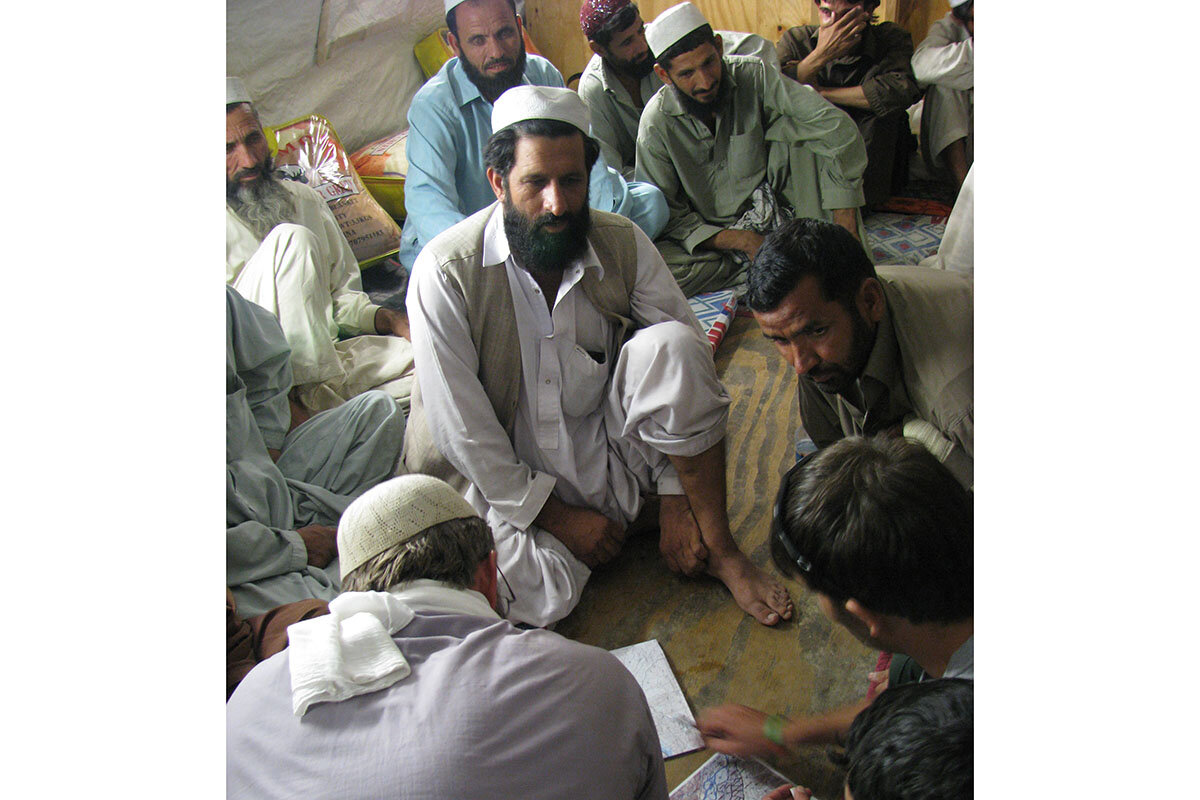- Quick Read
- Deep Read ( 6 Min. )

Why is Christian Science in our name?
Our name is about honesty. The Monitor is owned by The Christian Science Church, and we’ve always been transparent about that.
The Church publishes the Monitor because it sees good journalism as vital to progress in the world. Since 1908, we’ve aimed “to injure no man, but to bless all mankind,” as our founder, Mary Baker Eddy, put it.
Here, you’ll find award-winning journalism not driven by commercial influences – a news organization that takes seriously its mission to uplift the world by seeking solutions and finding reasons for credible hope.
Explore values journalism About usMonitor Daily Podcast
- Follow us:
- Apple Podcasts
- Spotify
- RSS Feed
- Download
TODAY’S INTRO
A ‘complicated place’
When most people think of Afghanistan, a war-torn, tumultuous country comes to mind. But Ann Scott Tyson holds a much more nuanced image. “Afghanistan is a very complicated place,” she says.
As you will read in our lead story, over the course of a year starting in 2011, Ann spent considerable time in two small villages in Konar province, in eastern Afghanistan. Living there while working on a book gave her unusual insight into how Afghan tribal culture works. And it deeply informs her understanding of how the Taliban took power this month.
There were rules and codes, of course; Ann understood the expectations that she would follow them. She also saw that while locals followed Islam, they weren’t dogmatic – they like their festivities, she says. People were adaptable – a family could have one son in the army, one in the Taliban. “People make deals at the rural, local level,” Ann says. “That’s how they function – and survive.”
Much of it comes down to problem-solving. “The elders can be very democratic and deft,” Ann says. But there’s also a strong culture of honor and shame – something you’ll see the impact of in her essay, which she wrote with her husband, Jim Gant, a retired Special Forces officer who commanded a small team of Americans conducting a tribal engagement mission in the area. That culture is a powerful force – and one Americans struggled to understand.
Ann told me that this was a particularly difficult story to write. “I want to give some insight into how the tribal dynamic works, and how the Taliban understood this, while the central government paid little attention to it at the grassroots. My hope is that when readers think about the Taliban, and how they pulled this off, they’ll have a better sense of what happened.”
Share this article
Link copied.

Help fund Monitor journalism for $11/ month
Already a subscriber? Login

Monitor journalism changes lives because we open that too-small box that most people think they live in. We believe news can and should expand a sense of identity and possibility beyond narrow conventional expectations.
Our work isn't possible without your support.
Essay
Afghanistan, in person: From tribal ties to pleas for help
In Afghanistan, the author and her then-fiancé in the Special Forces experienced firsthand the country’s close-knit tribal fabric, which plays a crucial role in peace and war.

-
Jim Gant Correspondent
It was 2011, and Ann Scott Tyson and her then fiance, Jim Gant, were living in eastern Afghanistan. Jim was a Special Forces officer on an extended mission to train and equip a tribal security force to keep the Taliban out of its territory. Ann had left her journalism job to document Jim’s mission for a book.
Malik Noor Afzhal, a Pashtun tribal elder, was worried about his fellow tribesman, Mohammad Jalil. Jim saw an opportunity to offer an olive branch, through the tribal connection, to Mr. Jalil’s Taliban brothers. The tribes offered not only a time-honored way to recruit local forces for village defense, but ultimately a path for reconciliation.
Afghanistan’s close-knit tribal fabric is at the center of the rural-based strategy that propelled the Taliban’s comeback this month. The tribes connect everyone from government officials and soldiers to farmers and Taliban fighters.
Those same tribal connections are in play today, we are seeing, as Afghans who helped the United States and other Western powers, try to find temporary safety as they seek a path for longer term security abroad.
Afghanistan, in person: From tribal ties to pleas for help

Noor Afzhal, a wise, white-bearded Pashtun tribal elder, a malik, or chief, whose imposing presence commanded respect, was worried about his fellow tribesman, Mohammad Jalil.
A burly man with dark, deep-set eyes, Mr. Jalil was in a bad spot. He served as a low-level government official in a district in Afghanistan’s eastern Konar province, but his two brothers were both leaders in the local Taliban.
After Afghan soldiers raided Mr. Jalil’s house, finding two rifles, they put him in jail. Seizing the weapons was the ultimate peghor, or shame, for a Pashtun male – and jail a harsh punishment.
“This is wrong,” the malik said, as he sat on a pillow in the large greeting room of his mud brick-walled compound, or qalat, carefully deliberating as he always did over tribal matters large and small.
It was the fall of 2011, and we were living in Mangwel, a village of the Mohmand tribe, surrounded by lowland fields of corn and wheat and bordered by the wide, glistening Konar River.
Jim was a Special Forces officer on an extended mission to train and equip a tribal security force to keep the Taliban out of its territory. I had left my journalism job to document Jim’s mission for a book, and we were engaged.
Always at Malik Noor Afzhal’s side, Jim saw the situation as a chance to offer an olive branch, through the tribal connection, to Mr. Jalil’s Taliban brothers.
For Jim, the tribes offered not only a time-honored way to recruit local forces for village defense, but also ultimately a path for reconciliation – a means to draw the insurgents down from the mountains and back home.
Those same tribal connections are in play today, we are seeing, as Afghans who helped the United States and other Western powers try to find temporary safety as they seek a path for longer-term security abroad.
Working together in 2011, Jim and Malik Noor Afzhal managed to get Mr. Jalil released to celebrate the feast after Ramadan. Later, Jim visited Mr. Jalil in jail, offered to meet his brothers, and promised he would take care of his family until he was freed. Mr. Jalil was deeply moved.
“Commander Jim,” Mr. Jalil said, “no one has come to see me, not even my own sons, but you come? My life is yours from now until the day I die.”
After that outreach, some Taliban members did switch to Jim’s side – with one becoming a tribal security force commander. It was a microscopic example of how the tribal umbrella can accommodate constantly shifting local alliances – often driven by calculations of raw power.
Taliban’s comeback strategy
Afghanistan’s close-knit tribal fabric is also at the center of the rural-based strategy that propelled the Taliban’s comeback this month. The tribes connect everyone from government officials and soldiers to farmers and Taliban fighters – often in the same clan or family.
The Taliban’s success hinged on their ability to leverage and pressure these tribes to dominate the countryside – isolating cities, the Afghan National Army, and ultimately the central government in Kabul.
The Taliban prevailed in part because they hewed far more closely than did the central government to Afghanistan’s tribal, valley-by-valley culture, in keeping with the country’s long tradition of decentralized rule.
In Konar, a strategic province on the border with Pakistan, the Taliban used deals and coercion to capture the most heavily contested northern districts in late July. By August, almost all the province’s rural areas were in the hands of the Taliban.
Today, as fate would have it, Mr. Jalil is the Taliban’s newly installed district chief in Khas Konar, overseeing Mangwel and other villages.
“We met with Mohammad Jalil; he says we are OK,” Asif, the son of the late Malik Noor Afzhal, said by phone from Mangwel on Sunday. “At least for now,” he added. “There are Taliban everywhere.”

Yet while fellow tribesmen may find a modicum of security in their kinship bonds, those who sided mostly actively with the U.S.-backed Afghan government against the Taliban are running for their lives, with reports of the militants going door to door tracking enemies.
“Only you can help me”
Niq Mohammed, a fearsome former Taliban member who helped lead an element of Jim’s tribal security force, told us through an interpreter on Sunday that he is in hiding. Now a farmer, Mr. Mohammed, his voice tense, asked for help in making an escape.
Indeed, tens of thousands of Afghans face imminent danger from the Taliban, and are frantically seeking a way out. They are sending an onslaught of emails, calls, and texts with desperate pleas to military veterans like Jim and Afghans who’ve already made it to the United States. “Wror [brother],” they say, “only you can help me.”
“I feel like a drowning man,” says Ismail Khan, a former interpreter with Jim’s team who also lived with us in Mangwel, his voice shaking. “I am grabbing whatever I can, to try to hold on.”
Mr. Khan, nicknamed Ish, chokes back tears, afraid for his friends and family and dismayed by the sight of the white Taliban flag raised on Aug. 15 over the presidential palace in Kabul. “I was overwhelmed with sadness,” Ish says of seeing that image.
Since Jim retired from Special Forces after 22 years of service in 2012, we’ve helped resettle his interpreters and dozens of other Afghan Special Immigrant Visa (SIV) holders in the Seattle area, greeting them at the airport and loading up U-Hauls with donated furniture.
We’ve been present at the birth of a vibrant and growing new Afghan community here, lending support as they adjust to a new country, learn English, navigate homeownership, and become U.S. citizens. Sitting on pillows in Ish’s Afghan-style living room sipping milk chai, we feel comforted knowing at least he made it out and is thriving, with five beautiful young children, including a newborn.
More will be welcomed soon. On Saturday came word that a leader of the Safi tribe, another Konar tribe we lived with, managed to get a flight out of the chaotic Kabul airport. A longtime fierce opponent of the Taliban, he was a marked man.
U.S. vetting
But too many risk being left behind, in part because the U.S. government’s extreme vetting has created a backlog of thousands of SIV applications, often imposing years of waiting on the Afghan men and women who have proved their loyalty to the U.S. in the combat zone.
One interpreter Jim worked with, Najibullah, served with Special Forces teams for nearly a decade starting in 2003. In 2008, he took part in a battle for which Staff Sgt. Robert Miller was posthumously awarded the Medal of Honor. But after waiting almost a decade, Mr. Najibullah still has no visa. Recently, one of his sons was killed by the Taliban.
To speed the evacuations, maverick teams cobbled together by veterans of U.S. Special Operations and civilians who served in Afghanistan are stepping into the gap, working day and night to open up new channels for exiting the country.
Motivated by a mutual love and respect, these U.S. and Afghan veterans lean upon one another as a way to heal the wounds of combat – intensified by the war’s sudden turn.
“Don’t lose hope,” Jim said recently to an Afghan interpreter seeking a way out for his family. “I hope,” the interpreter said, his voice cracking, “but I don’t believe.”
Ann Scott Tyson covers China and northeast Asia for The Christian Science Monitor. She is the author of “American Spartan: The Promise, the Mission, and the Betrayal of Special Forces Major Jim Gant.”

A deeper look
Dawn of the electric vehicle age? One car shopper’s experience.
Many people tout the coming electric vehicle revolution. Yet EVs still make up only 1.8% of the car market. Will the early 2020s end up being a pivot point for the industry, or will EVs remain a novelty?

- Quick Read
- Deep Read ( 12 Min. )
From auto shows to America’s public consciousness, electric vehicles keep popping up.
Entrepreneurs and established automakers have fired up assembly lines. Scientists are racing to improve batteries. Investors are banking millions on the hope they’ve found the next Henry Ford. It’s a burst of innovation not seen since the dawn of the auto age.
And yet, when EV sales reached a record share of the car market last year, they stood at 1.8%, or less than 1 in every 50 cars sold. All automakers except for Tesla lose money every time they sell an EV.
In the 1800s, cars powered by steam, gasoline, and electricity were all vying for supremacy. Gasoline won out, but now the field is becoming fluid again. Governments from the United States to Europe to China are pushing emissions regulations and tax incentives to help EVs take off.
Our correspondent finds himself at the Chicago Auto Show, as Indiana resident Mary Beermann goes on a quest to buy her first electric car. Despite the obstacles the industry faces, she's almost overwhelmed by how many models are on display. More are coming.
All of which leads to a pressing question: Is Mary in the vanguard of the next great automotive revolution? Or will EVs remain the province of a relatively small number of kilowatt connoisseurs?
Dawn of the electric vehicle age? One car shopper’s experience.
Seated for the first time in an electric car – a Ford Mustang Mach-E so new it doesn’t have a sticker price yet – Mary Beermann has a broad grin on her face. She struggles to open the doors, the trunk, and even the cover to the connector plug – a boomer flailing in the push-button dawn of the electric-car age.
But none of this seems to daunt her.
“I think this is it,” she says. “This is my next car.”
It’s partly my doing, really. A few weeks earlier, Mary had called me to ask for friendly advice about buying an electric car. I had almost bought one three years earlier. So when I was ready to write a story on whether electric cars are winning over the public, I asked Mary if I could tag along while she went through her buying process. And that is why, after a ridiculously early flight from Boston, I am standing with Mary at Ford’s outdoor demo area at the Chicago Auto Show in the rain.
Around the show, as in America’s public consciousness, electric cars keep popping up. New entrepreneurs, as well as established automakers, are tooling production lines to build them. Scientists are racing to improve batteries. Investors are banking millions on the hope they’ve found the next Henry Ford. It’s a burst of innovation not seen since the dawn of the auto age.
Even the federal government is involved. In a bid to reduce greenhouse gas emissions, the Biden administration in early August set the ambitious goal of having electric vehicles make up half of U.S. car and light truck sales by 2030. That’s twice the market share that many analysts see as feasible by the end of the decade.
To achieve that, or even get close, EVs are going to have to break out from their niche, which skews male, young, and affluent, and attract Middle America – everyone from new Generation Z drivers to seasoned baby boomers like Mary. It won’t be easy.

“The consumer has to see a greater value than in the [gasoline-powered] vehicle,” says Tom Libby, an automotive analyst at IHS Markit, a global market research firm. “Now, the only brand that is seeing that is the Tesla.”
At the auto show, Ford has pulled out a lot of stops to showcase its EVs. Usually, the show takes place in the winter and all the action is on the show floor inside. But at this pandemic-delayed and scaled-down summer event, while the conventional cars are on the convention floor, Ford and other automakers have moved their EVs outside for test-drives. An army of Ford ushers and presenters shepherds a long line of showgoers through a tent to show off the Mach-E and the Lightning, Ford’s first all-electric pickup truck due out next spring. Interest is high.
“I’m just curious,” says Juan Carlos Rodriguez, a civil engineer from Chicago, peering at the Mach-E. He cares about the environment and the cost. He currently commutes to work 17 miles one way in his Mercedes SUV, which is great on the open road, but has awful mileage when he’s stuck in traffic.
After the tent presentation, with lots of flashing lights and sound effects, we take a ride. John Grant, a Ford demonstrator, starts by putting the Mach-E into “unbridled” mode and accelerates in a special lane. The force pins us to the back of our seats. Mary screams.
The ride on Chicago streets is more mundane. Mary likes the expansive view she gets from the front seat. She’s already checked, with her own measuring tape, that she can raise the driver’s seat as high as in her Ford Escape, the vehicle she is seeking to replace.
The rest of the morning is a blur of EVs and salespeople. Mary test-drives Volkswagen’s new electric ID.4, which feels more Volkswagen than pathbreaking EV. And Mary doesn’t like the twisting shifter on the column of the steering wheel. Upstairs on the show floor, she looks at Chevy’s redesigned electric Bolt, a Kia, a Lexus, and other models recommended by her mechanic. Instead of the search narrowing down her focus, her choices are proliferating. More than 20 models of EVs are on display this year and double that number are expected next year.
All of which leads to a pressing question: Is Mary in the vanguard of the next great automotive revolution – will we all look back on the early 2020s as the time when the industry finally started to pivot away from the internal combustion engine, or will EVs remain the province of a relatively small number of kilowatt connoisseurs?

In many ways, today is reminiscent of the early days of automobiles, when cars powered by steam, gasoline, and electricity were all vying for supremacy. Vehicles were expensive, so mostly wealthy people were buying them. Back then, the widespread opinion was that gasoline, steam, and electric vehicles would all find their place in the 20th century, says David Kirsch, business historian at the University of Maryland and author of the book “The Electric Vehicle and the Burden of History.” “The big surprise was ... only internal combustion really survived past World War I.”
Mr. Ford had a lot to do with that. He focused so keenly on cost-cutting that by 1923, the price of a new Model T was less than half the $850 price tag of the 1908 original. The value to people was so obvious – cheap transportation – that it became the automotive equivalent of a slam-dunk. Millions of Americans snapped them up. In the face of that breathtaking innovation in internal combustion engines, steam-powered cars died, and electric ones faded into the background.
Mary’s reasons for considering an electric – for buying a new car, at all – are more complex. Before her husband, Ron, died earlier this year, he talked about replacing their aging Ford Escape. Mary has also inherited a car from her mother, who no longer drives. It’s a low-mileage, 11-year-old Milan from Mercury, a nameplate that no longer exists. Mary doesn’t seem ready to embrace a dated car from an obsolete division of Ford as her vehicle of choice.
Maybe it’s the Milan’s champagne color. Or maybe she’s decided to step out on her own. Ron always bought Fords, because a family member worked for the company and could get him a no-haggle discount. “Now that Ron isn’t here, I’m thinking I should break out of the mold,” she says.
Mary came to the auto show with her niece, Ann McCurties, and her husband, Marshall, who have also spent the morning test-driving cars. Then they meet up and compare notes. Both millennials, the McCurtieses also liked the Mustang Mach-E, but they’re thinking of starting a family, so they’re more excited about a conventional Kia SUV. Then, a surprise:
“I don’t want to talk you out of an electric car, because it’s really cool,” Ms. McCurties tells her aunt. “But going electric requires a life change.”
“You are always [going to be] a little more tethered to home,” Mr. McCurties chimes in, referring to the need to keep it charged.
Drivers ages 18 to 44 are supposed to be big cheerleaders for EVs. While they make up a third of the conventional car market, they accounted for 42% of EV sales through May of this year, according to IHS Markit. Despite that, many millennials, like the McCurtieses, remain skeptical about the current technology.
It’s not just the range problem: The batteries usually last less than 350 miles before they need to be recharged. Except for the costliest chargers, it takes some time to replenish the batteries. And charging stations of any type are still relatively scarce in some parts of the country, especially outside big urban areas. Then there’s the price. The McCurtieses test-drove a conventional Bronco Sport, whose models start at $27,215. The Ford Mach-E is $42,895, though savings on gas and maintenance for an EV (no tuneups or oil changes) as well as government rebates can close that gap significantly.
Separately, Mr. McCurties expresses support for the idea of reducing greenhouse gas emissions by going electric. But “we don’t have the extra $10,000 for the eco choice,” he says. (A week later, Mary will surprise the couple by giving them her Ford Escape, leaving her just the Mercury.)
At this point, I’m having trouble concentrating on the cars. It’s past noon and I’m running on one plastic cup of 7UP and an airline pack of crackers. Two catering employees walk by rolling multitier carts filled with plates of something brown. The plastic sheets over the carts make it impossible to tell whether it’s meatloaf or chocolate cake. At this point, I’ll take either.
Mercifully, we leave the show and decide to have lunch. Then we head to Valparaiso, Indiana, Mary’s hometown.
Northern Indiana is auto country. While Michigan gets all the attention because that’s where many of the cars are assembled, Indiana specializes in parts: engines, emissions systems, electronics, and so on. Hoosiers, in other words, know their cars.
The next morning, we drive to Team Chevrolet, a local dealership, to test-drive a Chevy Bolt. Christian Little shows off the revamped model of the electric vehicle, which General Motors has been selling since 2016. He answers Mary’s questions about the cost of a replacement battery (about $7,500) and pops the hood to demonstrate how it uses brake and window washing fluid but doesn’t need the oil or transmission fluid that conventional cars do. Then he asks Mary what power company she uses and pulls up a calculator on his phone to show her what it would cost to “fill her tank,” so to speak – $8.58.
For the test-drive, Mary asks Mr. Little to take the wheel first. He demonstrates one-pedal driving, the mode in which electric cars start braking as soon as you lift your foot off the accelerator. (The car is actually recapturing its forward momentum to regenerate the battery, which gives the car a little more range. You almost never need to use the vehicle’s real brake.) And with the car’s adaptive cruise control, the Bolt can accelerate in traffic or come to a complete stop without human intervention. Mary asks how long it took to get used to operating the car. About a month, Mr. Little tells her. Tentatively, she takes the wheel and tries out one-pedal driving mode, then turns it off, then turns it on again.

The T word – Tesla – comes up. The Palo Alto, California, manufacturer is the gorilla of the EV market in the United States, accounting for 4 of every 5 electric vehicles bought last year. Tesla also had 4 of the 5 bestselling models in 2020, with only the Chevy Bolt, at No. 3, keeping Tesla from a sweep. Still, Chevy sold fewer than 20,000 Bolts last year, less than a quarter of Tesla’s bestselling Model 3.
“People who are looking at a Tesla Plaid [a high-end Tesla model] for $100,000 are not going to be looking at a Bolt,” Mr. Little says. “Those are two completely different customers.”
Tesla still appeals to the more affluent, according to IHS Markit. Overall, 17% of buyers of conventional cars earn $200,000 or more. For EVs (which basically means Tesla, since it dominates sales), the share of high-income buyers is double that – 36%. By branding the Bolt as a Chevy, General Motors is aiming at the middle class.
Later, I ask Mary about test-driving a Tesla. “I think they’re ugly cars,” she says. The closest dealership is Chicago, more than an hour away, so she’s not interested. Instead, over a tuna sandwich and potato-ham soup at the Viking Chili Bowl, she tells her mother about how the Chevy Bolt costs only $8 to charge up.
“And do you use a regular outlet?” asks her mother, also named Mary. (Some electric car owners do, although many speed up the process with a 240-volt outlet typically used for an electric clothes dryer. Chevy offers to install one for free for new Bolt owners.)
Her mother goes on to reminisce about when she was a young girl and used to watch her father crank up their Model T. That crank kept many women from driving the early gasoline-powered cars because cranking was difficult and something women didn’t tend to do. Those who could afford electric vehicles continued driving them well after the Model T appeared, partly for this reason. This included Clara Ford, Henry Ford’s wife. He eventually solved the problem by replacing the crank with an electric starter.
While Ford – and other major automakers – publicly tout electric cars as the future and are spending hundreds of billions of dollars to gear up for it, the current reality is starkly different. For one thing, all automakers except for Tesla lose money every time they sell an EV. That’s why Mr. Little, who has sold five Bolts, is paid a salary by the company to be the dealership’s electric evangelist. There’s virtually no commission on the Bolt. Also, consumers aren’t exactly beating down dealers’ doors to buy electric cars. Last year, EV sales reached a record share of the car market – 1.8%, or less than 1 in every 50 cars sold.
Yet most car companies are true believers in an electrified future. Jaguar says it plans to sell only electric cars starting in 2025. Volvo will be turning out only EVs by 2030 and GM by 2035. Other manufacturers are making similar commitments.
Consumers who go electric often become evangelists. The enthusiasm of Tesla owners is legendary. Even Bolt buyers are devoted. “It’s fun to drive,” says Ralph Kleeber, a retired casino security director from Wisconsin, who attended the Chicago Auto Show and was considering replacing his older model with the new Bolt EUV.
His enthusiasm is infectious. His grandson, Jacob, has his eye on a Ford F-150 Lightning, the electric truck. “It’s a little bit cheaper to operate,” he says.
But EV companies will have to do a lot more to win over Middle America. One possibility is that the technology has its Model T moment. A breakthrough battery with more range and lower costs would make EVs more competitive with conventional cars. Cheaper manufacturing costs would also help, although only Tesla so far has demonstrated the ability in the U.S. to cut costs on the factory floor. Chinese and European car companies are also competing hard, so a battery breakthrough or lower factory costs could come from overseas.
Another possibility is that a sustained surge in gasoline prices would make the EV’s lower operating costs even more compelling.
Absent such events, however, the industry may need government help. The European Union and China have used tighter emissions rules to create EV markets that are bigger than America’s. The EU has also added a €6,000 ($7,000) incentive for EV buyers that, unlike the $7,500 U.S. federal tax credit, doesn’t run out after a company has sold 200,000 electric vehicles. (Already, Tesla and GM cars no longer qualify.) The Biden administration has talked about eliminating the 200,000 cap, turning the tax credit into a rebate, and increasing it to $10,000 for EVs manufactured in the U.S. and $12,000 for U.S. EVs built by union workers.
If successful, the incentives could jump-start EV sales. If not, U.S. automakers could be stuck with a big backlog of unsold electric cars.
“I’m of two minds. The sort of policy wonk in me says this is just about a managed transition,” using government intervention to move from one technology to another, says Professor Kirsch, author of the book on EV history. But “as a professor of entrepreneurship and someone who thinks a lot about capitalism, our history with managed transformations is pretty poor.”
Two weeks after the auto show, I return to Indiana where Mary and I drive to Schererville. She wants to test-drive Volvo’s first full electric vehicle, the 2021 XC40 Recharge.
Mary’s clearly done her homework, reading up on EVs and turning to YouTube reviews of the various cars. Her questions are sharper and more to the point. She wants to know about maintenance costs. Is there a spare tire? (To save weight, the Recharge is equipped with run-flat tires, instead.) What would it cost to lease the car?
Leasing could be a smart move. Because electric cars are expected to be dramatically better and possibly cheaper in a few years, many electric-car reviewers suggest leasing instead of buying one. Mary also takes the wheel more confidently, including the one-pedal driving option.
“You definitely have to get used to it, but it does – as you say – recharge the battery,” she says. “It’s a beautiful car. Absolutely!”
Later, we talk about what she’s thinking after weeks of researching and test-driving electric vehicles. “If someone handed me $100,000, I would say I would take the Volvo tomorrow,” she says. Also, “I don’t know why, I’m drawn by the Chevy Bolt. [But] I can’t justify $40,000 for a Chevrolet.”
“I think I should definitely test-drive a Mach-E,” she adds. “It was very comfortable and it’s a solid body.” Supplies of the electric Mustang are so tight that none of the dealers in the area has one, even for a test-drive. One dealer tells her of a Mach-E now being built, which she should be able to take out for a spin at the end of August.
The whole experience hasn’t turned her off from EVs but neither has it convinced her to make the switch, not even to the Mach-E she finds so cool. “I’ll test-drive it and two other [conventional] Fords and choose from them,” she says.
America is still waiting for that EV slam-dunk.

The Explainer
Tribal colleges honor students’ past, prepare them for future
Nation building isn’t typically part of a school’s purpose. But for tribal colleges and universities, helping to perpetuate Native American cultures and communities is foundational.

- Quick Read
- Deep Read ( 3 Min. )
The College of Menominee Nation is one of more than 30 tribal colleges and universities (TCUs) in the United States. Jasmine Neosh, who’s studying public administration there, calls tribal colleges like hers the “greatest-kept secret in higher education.”
The first TCU was founded in Arizona in the Navajo Nation in 1968. Primarily located in the Midwest and Southwest, TCUs serve over 30,000 students. Their foundational purpose is to provide a culturally relevant educational experience to American Indians while also meeting the needs of the community by training future workers.
Almost three-quarters (74%) of TCU alumni are primarily employed in areas related to American Indian communities or tribal lands, according to a 2019 Gallup report. What’s harder to tell, says Ms. Neosh, is just how much of a ripple effect that has.
“TCUs prepare us to take that next step,” says Jacob McArthur, a recent graduate of White Earth Tribal and Community College in Minnesota. “Along the way, it allows us to reconnect with our culture and bring it back into the community.”
Mr. McArthur is on track to earn his master's in business administration from a state school this fall. His job now? Working in the IT department at his tribal college alma mater.
Tribal colleges honor students’ past, prepare them for future
After doing well in classes at two Chicago colleges, Jasmine Neosh still felt like something was missing. Transferring a second time to the College of Menominee Nation, a tribal college in Wisconsin, she found the missing piece.
“It wasn’t only acceptable that I show up as my whole self,” says Ms. Neosh, a member of the Menominee Nation. “It was expected.”
The College of Menominee Nation is one of more than 30 tribal colleges and universities (TCUs) in the United States, which serve over 30,000 students. At a time when discussions of Indigenous education are receiving widespread attention, Ms. Neosh calls tribal colleges like hers the “greatest-kept secret in higher education.”
“There’s an entire model here,” she says, “that would benefit the rest of the country to see.”
What is a TCU?
Primarily located in the Midwest and Southwest, TCUs have the foundational purpose of providing a culturally relevant educational experience to American Indians while also meeting the needs of the community by training future workers.
TCUs provide education, says Ms. Neosh, “so that people can immediately go back to work and start trying to improve things.”
With nearly a quarter of American Indians living in poverty compared with 13.4% of the overall population, TCUs provide educational access and opportunity.
The natural-resources associate degree program at the College of Menominee Nation squared with Ms. Neosh’s interest in the environment, something deeply rooted in the Menominee culture, which highly values forests. She is now seeking her bachelor’s degree in public administration from the college and has her sights set on law school.
Almost three-quarters (74%) of TCU alumni are primarily employed in areas related to American Indian communities or tribal lands, according to a 2019 Gallup report. What’s harder to tell, says Ms. Neosh, is just how much of a ripple effect that has. This dual purpose of education and community building harks back to the founding of the colleges themselves.
What is the history of TCUs?
Compared with historically Black colleges and universities, or HBCUs, whose origins predate the Civil War, tribal colleges are relatively new institutions, with the first one founded in Arizona in the Navajo Nation in 1968.
During the 1960s, broader societal questions about identity and “who am I?” surfaced, says Charles “Monty” Roessel, current president of Diné College, the first tribal college.
In the years prior, from 1953 to 1968, the official U.S. government policy toward Indigenous people encouraged relocation to urban areas and attempted to terminate the trustee relationship between the federal government and tribes.
“If you look at what happened and the history, [the idea for tribal colleges] doesn’t start with 1968,” says Dr. Roessel, the son of the college’s first president. “It starts back in the Termination Era, where the idea of resilience, tenacity, and humanity really starts.”
The educational institutions teaching Native history, language, and culture were vital to the tribes’ exercising their sovereignty as nations, Dr. Roessel says. “One of the things that all tribal colleges have in common is the idea of nation building,” he adds.
At Diné, what started as a community college with the first American Indian studies program developed into a four-year institution with Navajo culture infused throughout its curriculum. Later, in 1983, two tribal colleges in South Dakota, Oglala Lakota College and Sinte Gleska College, took over the lead, becoming the first nationally accredited tribal colleges to offer bachelor’s degrees. Now, over a dozen tribal colleges offer a bachelor’s degree or higher, including Diné, which bestowed its first bachelor’s degrees in 1998.
How do TCUs prepare students for the future?
For students like Jacob McArthur, a member of the White Earth Ojibwe, his time at White Earth Tribal and Community College in Minnesota served as a bridge to a state school.
“TCUs prepare us to take that next step,” the recent graduate says. “Along the way, it allows us to reconnect with our culture and bring it back into the community.”
Mr. McArthur is on track to earn his master’s degree in business administration from a state school this fall. His job now? Working in the IT department at his tribal college alma mater.

In Pictures
From wrecked pier to public park: Exploring New York’s Little Island
Space is a hot commodity in dense cities. In New York, a "little Oz" built over the remains of a hurricane-wrecked pier is changing ideas of how – and where – to build parks.

-
Sarah Matusek Staff writer
From wrecked pier to public park: Exploring New York’s Little Island
A new Gotham green space hovers above the Hudson River. Open since May, Little Island boasts selfie-worthy views of the jagged Manhattan skyline. The addition to Hudson River Park leads guests up a gangplank to a space – upheld by tulip-shaped concrete columns – where they can traipse short trails, enjoy live performances, and picnic on a grassy slope. The city is inseparable from the human-made oasis, as chatter blends with the muffled roar of the West Side Highway.
Private money props up the public park. Developed over a decade, Little Island was mostly funded by the family foundation of media mogul Barry Diller and fashion designer Diane von Furstenberg. (The couple’s philanthropy also supports the nearby High Line, an elevated park.) Mr. Diller conceived of Little Island, whose structure was designed by Heatherwick Studio in London. New York-based MNLA designed the landscape, which rises above the remains of a hurricane-wrecked pier.
Currently, visitors to the park, which is free, must make timed-entry reservations from midday onward to help curb crowds. With 2.4 acres to explore, there’s not much space for solitude. But the petite park offers something pandemic-weary New Yorkers might crave even more: whimsy. “For me, if you walk up that bridge and you leave New York behind, and you enter our little Oz, and it brings you pleasure, it was all worthwhile,” Mr. Diller told The Wall Street Journal.
Waist-high blooms abound. Square tiles tinkle like bells when tapped by feet. One June afternoon a boy rolls down the slope, his shirt picking up loose strands of grass.
Little Island is open daily from 6 a.m. to 1 a.m. Free, timed-entry reservations are required from noon onward.








Other headline stories we’re watching
(Get live updates throughout the day.)The Monitor's View
Tutoring the Taliban on humanitarian law
- Quick Read
- Deep Read ( 2 Min. )
-
By the Monitor's Editorial Board
This past April, when President Joe Biden announced that U.S. forces would be leaving Afghanistan, the aid group Geneva Call also announced an app for the Afghan people. It was the latest example of international efforts to engage all Afghans – especially the Taliban – to respect humanitarian law and protect the innocent. With chaotic scenes at the Kabul airport, one might think that spreading the principles of safety for civilians in harm’s way might not be sinking in.
Yet in mid-August, as the Taliban were taking over the capital, United Nations Secretary-General António Guterres said the group would work with existing institutions that have aided hungry and injured Afghans. He said U.N. humanitarian workers have remained in territory already under Taliban control.
Efforts to persuade the Taliban to honor neutral aid groups – and humanitarian law in general – have not been easy. Yet a study by Geneva Call found that nonstate armed groups often come to appreciate humanitarian law after being exposed to aid workers. Protection of such workers in Afghanistan could suggest the Taliban might be more protective of all civilians. Assisting innocent civilians can inspire an appreciation of innocence itself and dampen conflict.
Tutoring the Taliban on humanitarian law

This past April, when President Joe Biden announced that U.S. forces would be leaving Afghanistan, the aid group Geneva Call also announced a smartphone app in three languages for the Afghan people. Called Conflict Has Rules Too, the app was the latest example of international efforts to engage all Afghans – especially the Taliban – to respect humanitarian law and protect innocent people in the country’s fragile and violent environment. With chaotic scenes at the Kabul airport of civilians trying to flee the country, one might think that spreading the principles of the Geneva Conventions – safety for civilians in harm’s way – might not be sinking in.
Yet in mid-August, as the Taliban were taking over the capital, United Nations Secretary-General António Guterres said the group would work with existing institutions that have aided hungry and injured Afghans. He said U.N. humanitarian workers have remained in territory already under Taliban control.
Other aid groups have reported arrangements with the Taliban, especially those aid groups that have been impartial humanitarian actors and did not take U.S. money or work with NATO forces. “Many aid organizations that have operated in Afghanistan for 20 years or more say they are determined to carry out their missions across the country,” reports Devex, a media site for the global development community.
Doubts about the Taliban’s ultimate intentions remain high. That is why the U.N. chief also called on the group “to exercise utmost restraint to protect lives and to ensure that humanitarian needs can be met.” An estimated half of all Afghans, or 18 million people, are in need of aid, a result of not only two decades of war but also the COVID-19 pandemic and a drought. And keeping foreign assistance in place is important for another reason: Seventy-five percent of all social services in the country have come through international aid groups.
Efforts to persuade the Taliban to honor neutral aid groups – and humanitarian law in general – have not been easy. Yet a 2016 study of conflict zones by Geneva Call found that nonstate armed groups often come to appreciate humanitarian law after being exposed to aid workers.
Protection of such workers in Afghanistan could suggest the Taliban might be more protective of all civilians. Assisting innocent civilians – with food, education, shelter, and hope – can inspire an appreciation of innocence itself and dampen conflict.
“It appears that the protection of genuine humanitarians ultimately rests on the integrity of their actions, underpinned by a universal instinctive belief in the sanctity of humanitarian work,” stated the World Economic Forum in a piece for World Humanitarian Day on Aug. 19. Perhaps that is why so many Taliban, after taking over a district, approached aid offices with an eye to keeping their work going.

A Christian Science Perspective
Each weekday, the Monitor includes one clearly labeled religious article offering spiritual insight on contemporary issues, including the news. The publication – in its various forms – is produced for anyone who cares about the progress of the human endeavor around the world and seeks news reported with compassion, intelligence, and an essentially constructive lens. For many, that caring has religious roots. For many, it does not. The Monitor has always embraced both audiences. The Monitor is owned by a church – The First Church of Christ, Scientist, in Boston – whose founder was concerned with both the state of the world and the quality of available news.
Spiritual synchronization
- Quick Read
- Read or Listen ( 3 Min. )
-
By Emmanuel Tekila
Mentally yielding to God, good, empowers us to feel God’s healing love and strength in our daily lives.
Spiritual synchronization
In technology, synchronization enables us to access the same information from one device to another. The data is stored in the cloud, accessible wherever we may be, even if we change devices. By creating a user account on a site or an app using cloud computing data storage, we can easily access our information by identifying ourself on the corresponding platform.
There’s another kind of synchronization I have found even more helpful in my daily life. It is illustrated in this passage from “Science and Health with Key to the Scriptures” by Mary Baker Eddy, who discovered Christian Science: “When mortal man blends his thoughts of existence with the spiritual and works only as God works, he will no longer grope in the dark and cling to earth because he has not tasted heaven” (p. 263).
For me this represents what we might call “spiritual synchronization.” When human thoughts yield to the will of God, which is always good and harmonious for each of us, we witness healing taking place. This is what Christ Jesus proved, including when he faced crucifixion yet asked for God’s will, not his own, to be done. Jesus looked to God as the source of his and everyone’s true, spiritual identity. This resulted in his many healing works and ultimate victory over death after three days in the tomb.
In our daily life, when the temptation to feel discouraged or hopeless jumps in – maybe at school, at work, or with family – we too can look to God, the source of the real “data” about each of us. We can identify ourselves spiritually, as God created us: as the image of His perfect nature, made up of spiritual qualities such as purity and completeness. This constitutes our true nature, which cannot be corrupted because God, Spirit, cannot be corrupted. Faced with a health crisis situation, a difficult assignment at school, or any other type of difficulty, mentally yielding to God, good, enables us to feel tranquility, spiritual strength, and God’s healing love.
During the exam period at the university I attend, there was much pressure to participate in corrupt practices. Word spread that if we didn’t give money to a teacher we were liable not to pass (even if we had earned a passing grade), and that certain teachers did not even let students take the exam unless they gave the teacher money.
I decided to turn to God in prayer, to “blend” my thought with the spiritual and seek God’s guidance. As a student of Christian Science, I have learned that God’s universe is filled with His spiritual offspring, who are obedient to the Divine. The divine Mind, God, is the only legitimate Mind and each one of us expresses that Mind. God being Love and each of us being the idea of God, our real being is made not of dishonesty but of righteousness, love, joy, and harmony. I understood this to be the real “data” of everyone.
I kept preparing for my exam by studying and praying in this way, rather than paying a bribe. When the time came to take the exam, I was able to do so peacefully, and when they published the exam results, I saw that I had successfully passed.
Whatever type of situation we may face, we can “[blend our] thoughts of existence” with what the divine Mind knows about us and others, realizing that God’s love is always embracing us, lifting fears and worries. What comes out of this is that, as the Bible says, “We all, with open face beholding as in a glass the glory of the Lord, are changed into the same image from glory to glory, even as by the Spirit of the Lord” (II Corinthians 3:18).
Isn’t such “spiritual synchronization” beautiful? Each of us can experience it right now and right here, and see its wonderful results.

A message of love
Moments of joy amid chaos

A look ahead
Thanks for starting the week with us. Come back tomorrow. We’re working on a profile of a GOP lawmaker whose former opponents call him “a person of integrity” – one of 10 GOP representatives to vote to impeach President Donald Trump.



